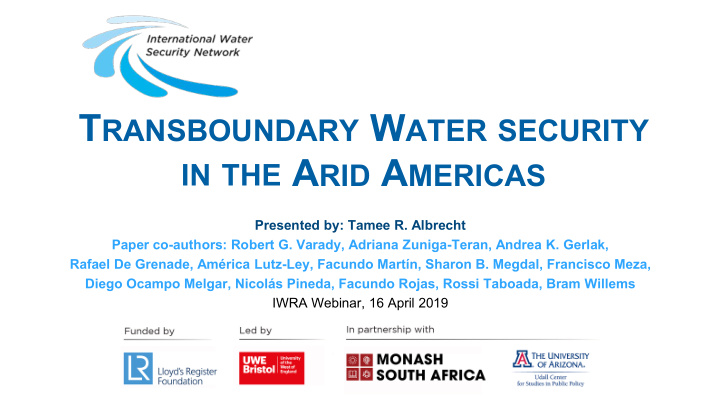



T RANSBOUNDARY W ATER SECURITY IN THE A RID A MERICAS Presented by: Tamee R. Albrecht Paper co-authors: Robert G. Varady, Adriana Zuniga-Teran, Andrea K. Gerlak, Rafael De Grenade, América Lutz-Ley, Facundo Martín, Sharon B. Megdal, Francisco Meza, Diego Ocampo Melgar, Nicolás Pineda, Facundo Rojas, Rossi Taboada, Bram Willems IWRA Webinar, 16 April 2019
Transboundary waters • Rivers that cross international (or state boundaries) • Rivers that form borders • Shared groundwater aquifers • Mountain source-waters that traverse borders • Water transfers • Shared infrastructure • Virtual water exports
Water security is multidimensional Human use Quantity Quality Environmental needs Definitions in the literature generally have at least 6 attributes
Water-security attributes Sources: FAO 1996; GWP 2000; Grey & Sadoff 2007; UNEP 2009; Norman et al. 2010; Zeitoun 2011; Lautze & Manthrithilake 2012; Bakker 2012; OECD 2013; UNESCO 2013; UN-Water 2013; Scott et al. 2013; Jepson 2014; Wheater & Gober 2015; Gain et al. 2016. Adapted and revised from Gerlak et al. 2018.
Water security is contextual… …how do borders matter? • Traverse continuous landscapes, ecosystems, habitats • Border regions share languages and cultural traditions …what institutional responses do we see in arid regions?
Cases from the Arid Americas 1. 1. Transboundary aquifer : Cooperation on scientific studies progresses amid contentious binational relations 2. 2. Binational desalination : International water transfers in fragile ecosystem & volatile political environment 3. 3. Transboundary river : Developing institutional arrangements for transboundary rivers amid international mistrust & dispute 4. Trans-jurisdictional river: Asymmetries between poor upstream & prosperous downstream provinces 4. 5. Shared glacial headwater: Industrial development and climate change threaten water availability for two nations 5. Map: Adriana Zuniga-Teran
Salient water-security attributes
Institutional Responses Case Advances Limitations 1. Santa Cruz • Binational scientific cooperation • Limited coverage for groundwater in transboundary aquifer, • Water Treaty binational water treaty US and Mexico • Social networks 2. Binational desalination, • Expands water supplies • Weak environmental policy in MX Mexico and US • Binational institutional capacity • Limited environmental protection and and national water management equity in binational benefits-sharing 3. Catamayo-Chira • Growing binational dialogue • Incongruous national water laws transboundary basin, • Binational peace agreement Ecuador and Peru 4. Ica River • Local-level planning and • Limited basinwide planning and equity interjurisdictional basin, cooperation • Limited support from higher governance Peru levels 5. Maipo-Mendoza • Binational scientific cooperation • National glacier protection law only in shared glacial headwaters, • Civil society leveraged support for Argentina Chile and Argentina a national glacier protection law in • Limited inclusion of glaciers in regional Argentina treaties
What can we learn? • Transboundary compounding factors • National sovereignty and priorities • Uneven capacities and relationships • Insufficient institutional capacity (national & int’l legal frameworks) • Some challenges are common among cases, but institutional responses vary • Climate change, water quantity, water quality and sanitation • Range from informal to formal • Local, national, international • Overarching need for greater governance capacity at multiple levels • Flexibility and adaptability • Fit for context
Thank you! Questions? talbrecht@email.arizona.edu www.watersecuritynetwork.org www.twitter.com/water_network Acknowledgement The project is funded by Lloyd’s Register Foundation, a charitable foundation helping to protect life and property by supporting engineering-related education, public engagement and the application of research. For more information, see: www.lrfoundation.org.uk
Recommend
More recommend